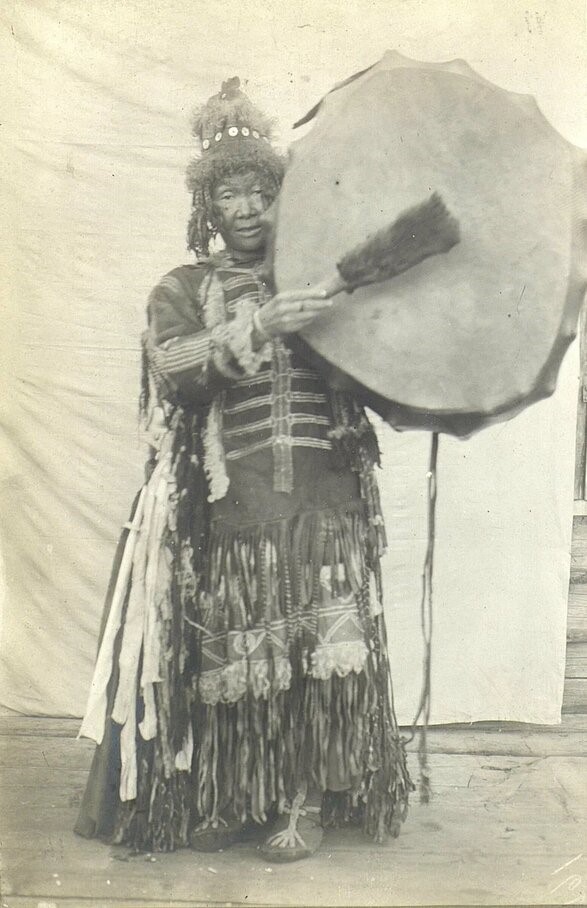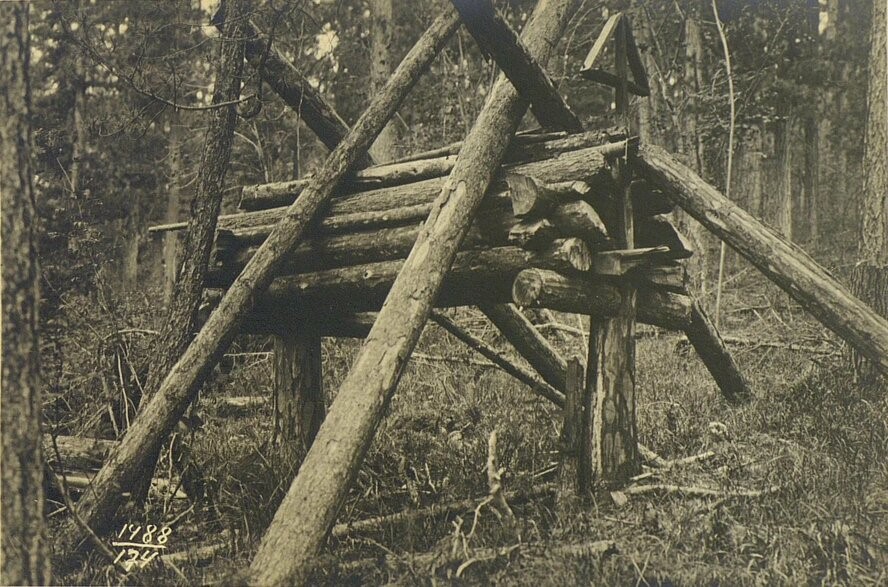|
|
Dr. Belyaeva-Sachuk
Senior Research Fellow, Arctic Research Center, Museum of Anthropology and Ethnography, Russian Academy of Sciences
|
The Tofalar. Spiritual Culture: Mythologies, Traditional Beliefs, Holidays, and Rituals
The religious beliefs of the Tofalar were based on shamanism. They believed that the world consisted of three levels inhabited by a large number of gods and spirits. In the upper world there lived the supreme deity (Burkhan, or Kudai) and his assistants. The middle world is populated by human beings, animals, and spirits. The Tofalar believed that some of those spirits help people while others seek to harm them. The Tofalar believed that they should offer gratitude to good spirits and appease the harmful ones.
The lower world is the kingdom of the dead, ruled by Erlik (Erlik Khan). People cannot enter the upper world, but sometimes they could fall into the lower world through holes in the ground, where they remained invisible to others. Only shamans can travel between the worlds and communicate with the deities and spirits. Over time, interactions between Tofalars and neighboring peoples resulted in bigger Buddhist and Orthodox influence on their beliefs.
Scholars have overlooked the Tofalar shamanism. One reason for that might be that since the beginning of the 20th century, few shamans had remained and not many of them were willing to communicate with ethnographers due to their prior conflict with Orthodox priests. Yet, one scholar did manage to photograph them and describe the shamanic attire. The shaman’s costume consisted of a long leather (suede) cloak with many cords and an embroidered image of a human spinal cord, ribs, chest and other bones. The shamans used a round tambourine with no images on it, symbolizing a mount, a beater, and a whip to urge it on with. Shamanism among the Tofalar had been widespread until the 1930s when the Soviet government essentially destroyed it during the anti-religious campaign.
In the middle world, the main deities were the master of the mountains (Dag-Ezi), to whom all the spirits of the mountains and taiga were subordinate, and the master of the water (Sun-Ezi), who ruled over the spirits of rivers, streams, and lakes. It was they who were primarily worshipped since the Tofalar believed that the well-being of the tribe depended directly on them. They especially revered the master of the mountains because he provided people with animals, and furs, protected them from large predators as well as kept the cattle safe. They also worshiped local deities at encampments offering them the jalama ribbons, which were tied to the branches of trees and bushes. They held public prayers for the master of the mountains three times a year: in May, during reindeer calving time, at the beginning of summer, before migrating to summer pastures, and in the fall, before the start of the sable hunting season. In order to do this, they brewed tea with lard, which they then donated to the master asking him for the tribe’s well-being. They brought lard to the fire separately. After this, they drank the tea and tied the sacrificial jalama to the trees. The hunters still perform a similar ritual when traveling in the taiga. They say they do this in the sacred places where their ancestors used to worship the spirits. The Tofalar also tie ribbons during the “Argamchi-Yry” summer festival, believing that it might bring them happiness and good luck.
The Tofalar communicated with water spirits when they had to cross a river. They offered the jalama tied to trees to the spirits and asked for a safe passage. In order not to anger the master spirit of the water, they strictly prohibited water pollution among themselves. For example, one could not throw dead flesh or anything dirty into the water. One could not use dirty containers such as sooty cauldron, a milk container, or anything unwashed to get water. If there were no other option, dirty utensils were to be rinsed before drawing water. One was and still is forbidden to wash clothes or a car in the river. However, reindeer herders are now allowed to dump the carcasses of dead animals into the river during calving. The rationale behind that is the concern that if a carrion remains close to the camp, it can attract predators.
The Tofalar also worshipped the spirit of fire. They often sacrificed the first food, tea, or alcohol to this spirit. According to the Tofalar, fire should not be insulted, spat on, or polluted. The Tofalar still continue to honor fire by treating it with respect, especially when they are in the taiga.
The Tofalar also saw taiga to be full of sacred places and objects. There were sacred trees (ham-nesh) or shaman trees with a bushy outgrowth of branches (a “witch’s broom” or hyperplasia). Such trees were especially respected: ribbons or sacrificial animal furs were tied to them.
Another sacred place is associated with the sacred kastyrma (kostyrma) stones, from the middle reaches of the Kastarma river. Kastyrma are imatra stones (clay-lime concretions) of various shapes - discoidal, figure eight, spinning top, and many others. They are considered to bring good luck and also work as a powerful amulet against snake bites. The Tofalar once were once sewed them onto clothes, especially for small children. Now they are one of the most interesting souvenirs you can bring home from Tofalariya.
Since the 19th century, the influence of Buddhism mostly from the Oka Buryats and less so from the Tozhu Tuvans, as well as Orthodoxy from the Russian settlers, has been increasing. The Tofalar came in contact with Buddhism not only through their contact with the Oka Buryats, but also through participation in the fair dedicated to the great Buddhist holiday of the Coming Buddha Maitreya (Buryat: Maidari-khural), which was held by the Zhelgen temple between June and July. The Tozhu Tuvans exerted much less influence, since they remained mostly shamanists. As early as the 18th century, the Tofalar were converted to Christianity but continued to worship shamanistic gods. In the 19th century, Yuli Shtubendorf wrote that, despite the efforts of the priests of the Biryusa mines, Orthodoxy was practiced only nominally, and the Tofalar would routinely turn to their shamans for help. Most Tofalar met with an Orthodox priest occurred only once a year during Suglan, which usually took place at the end of December during the holiday of St. Nicholas of Winter, the day of remembrance of St. Nicholas the Wonderworker on December 19. During Suglan, all newborn children were baptized, all couples married, and the funeral services held for all those who had died during the year. Today there are no shamans among the Tofalar, although in the 1990s, there were attempts to revive the shamanic tradition. Many consider themselves Orthodox, but there are still no churches in Tofalariya.






























































